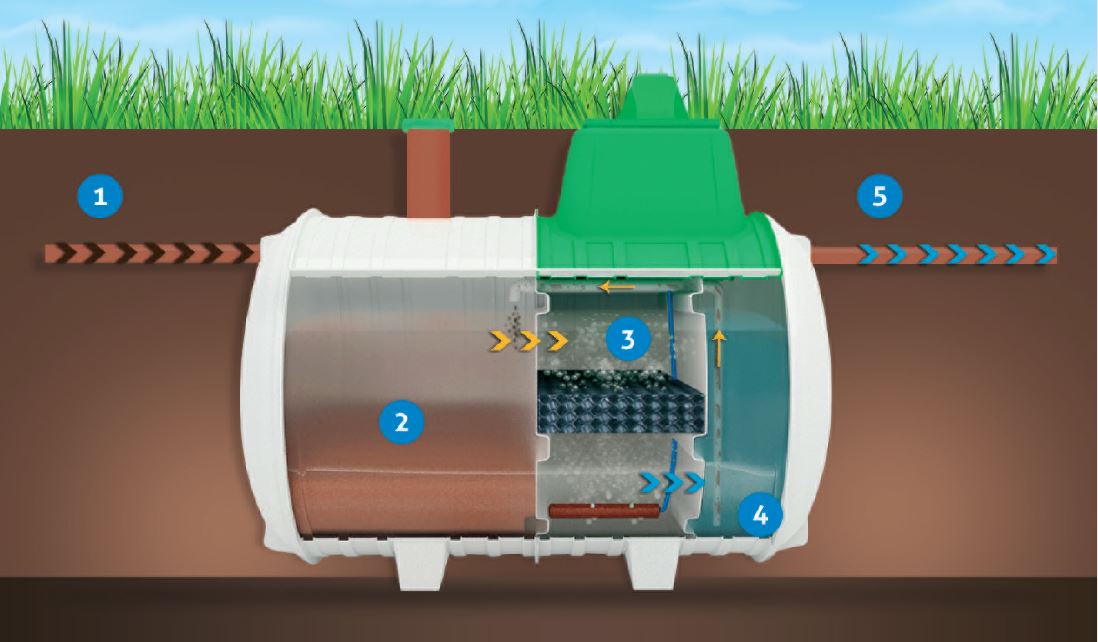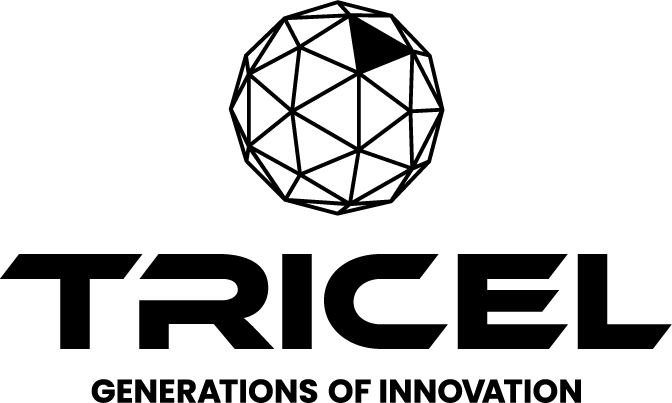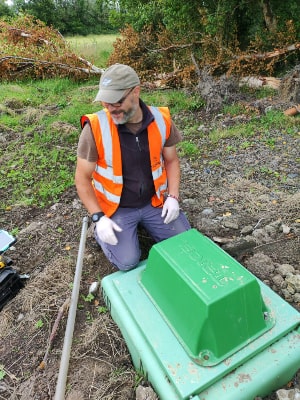Waste water treatment plants
Is installing a septic tank without a percolation area in Ireland possible?
Overview
A house not connected to main sewers needs a domestic waste water treatment system. This system will treat the wastewater produced. Wastewater comes from toilets, showers, sinks, washing machines, dishwashers.
Is it possible to install a septic tank without a percolation area in Ireland?
This question is answered below. We will cover the following topics:
- What is a septic tank, and how does it work?
- What is a percolation area, and how does it work?
- How does a waste water treatment plant work?
- The role of the site assessor
- Conclusion: is it possible?
You can also reach out to us and we’ll discuss the options with you.
Request a call back for more information
What is a septic tank, and how does it work?
A septic tank is a underground chamber for basic sewage treatment. The solids settle out and form a sludge which we empty from time to time to prevent blockage. The liquid then flows on through the tank; no mechanics and no electricity requirement.
See below the drawing of how does the Tricel Vento septic tank work.
The wastewater from the house comes in (1). Solids sink to the bottom. Lighter matter like fat rises to the top, forming a scum layer.
The waste water overflows into the chamber (2), and then it can be discharged to a specially designed percolation area or into a secondary treatment system to meet the EPA standards.
A septic tank is referred to as a primary treatment of the wastewater. The wastewater from a septic tank is not fully treated. Further treatment is needed before it can be discharged into the environment. This treatment can be from the soil/ground, a sand polishing filter, or a package filter system.
The most basic type/set-up of waste water treatment system is a septic tank and percolation area.

What is a percolation area, and how does it work?
The design of the septic tank helps to remove heavy particles from wastewater. Only the liquid portion is allowed to flow into the percolation area.
The percolation area consists of a series of perforated pipes buried in trenches that we fill with gravel. It distributes wastewater evenly over the surface of the gravel and percolates, or filter, through the soil.
As the wastewater moves through the soil, it naturally treats water by a combination of physical, biological, and chemical processes. Microorganisms in the soil break down organic matter and pollutants, while soil particles trap suspend solids and nutrients. The filtered water then percolates into the groundwater, where it treats further the wastewater and eventually replenishes local water sources.
It is important to note that the effectiveness of a percolation area for wastewater treatment is dependent on several factors. These include soil type, slope, and drainage. Proper design, construction, and maintenance are essential to ensure the system functions properly and does not pose a risk to public health or the environment.
How does a waste water treatment plant work?
We design Wastewater treatment plants to treat the sewage and wastewater that households, businesses, and industries generate. The treatment process involves a series of physical, biological, and chemical processes that remove contaminants from the wastewater and make it safe to release into the environment.
Below are the steps involved in the wastewater treatment process of a Tricel Novo wastewater treatment plant.
- The plant receives wastewater from the dwelling, toilets, sinks, showers, etc.
- The primary settlement chambers receive the effluent. The settlement process occurs when heavier solids drop out of the wastewater and settle to the bottom of the tank, whereas lighter solids float to the top.
- The next chamber is the aeration chamber, where naturally occurring bacteria inhabit specially designed plastic filters. By feeding on the waste, the bacteria remove it from the liquid. These bacteria are sustained by a continuous supply of air from the compressor under the hood (on top of the plant). In order to ensure high treatment efficiency, wastewater passes through the filter media repeatedly.
- After that, the liquid proceeds to the final chamber for settlement. In this chamber, any remaining minute bacterial particles are separated from the liquid before being discharged. By slowing the liquid’s velocity, any final trace impurities settle into the tank’s bottom. A sludge return system returns these impurities to the primary settlement chamber.
- Now that this effluent has been treated, it is ready to be discharged into a suitable discharge area, as required by the local authority.
This is the process for a Novo wastewater treatment plant with fixed bed technology. It’s important to note that the treatment process can vary depending on the specific plant and the level of contaminants in the wastewater being treated. However, the basic steps above are common to most wastewater treatment plants.
Sewage treatment plants offer a higher level of treatment than standard septic tanks.

The role of the site assessor
In Ireland, a site assessor is responsible to determine whether a site is suitable for a domestic waste water treatment system.
The following are the key responsibilities of a site assessor in Ireland:
- Conducting site assessments: The site assessor is responsible for conducting a thorough assessment of the site, including examining the soil type, drainage, and topography. They will also evaluate any potential hazards or risks associated with the site.
- Providing recommendations: Based on the assessment, the site assessor will provide recommendations for the site’s use. For example, they may recommend that the site is suitable for building a house, installing a septic tank, or other uses.
- Preparing reports: The site assessor is responsible for preparing detailed reports outlining the findings of the assessment and the recommendations for the site’s use. Local authorities typically use these reports to make decisions on planning and development applications.
- Staying up-to-date with regulations: Site assessors must remain up-to-date with relevant regulations and guidelines related to site assessments and land use. This includes knowledge of planning regulations, building codes, and environmental legislation.
Overall, the role of a site assessor in Ireland is crucial in ensuring that development and land use decisions are made based on accurate and thorough assessments of the site’s suitability. Their work helps to protect the environment, ensure public safety, and promote sustainable development.
Conclusion: is installing a septic tank without a percolation area in Ireland possible?
No, it’s not possible, Ireland requires a disposal route before discharging to ground.
Tricel can help with your wastewater treatment project; we offer septic tanks, wastewater treatment plants, sand polishing filters and packaged filter systems.
The latter provides solutions for sites without room for percolation areas or when you need further treatment.
Get in touch
HQ
Tricel (Killarney) Unlimited Company
Ballyspillane Industrial Estate, Killarney, Co. Kerry, V93 PN84, Ireland
Tel: 00353 (0)64 6632421

